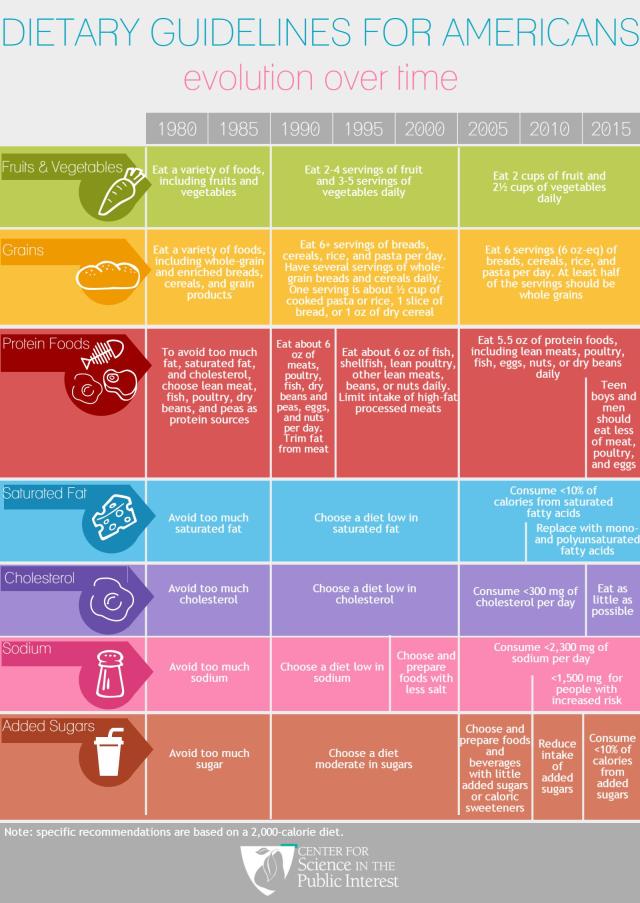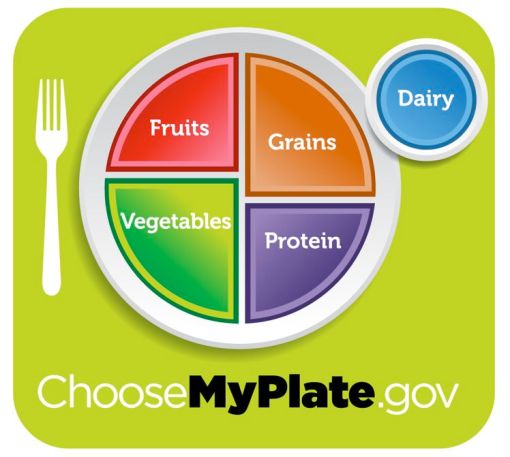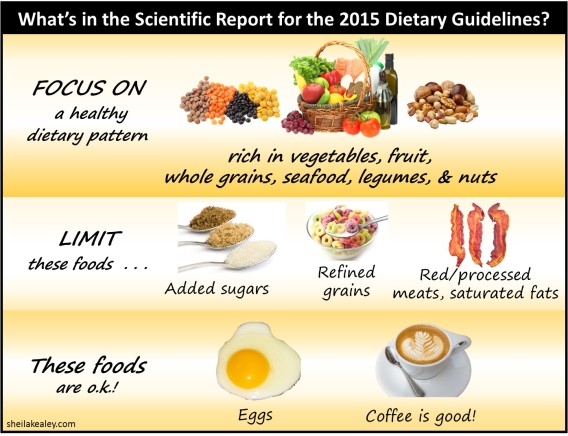What is the DGA?

The Dietary Guidelines for Americans (DGA) is the main reference for nutrition advice in our country, aiming to help Americans eat a healthier diet.
The document is collaboratively developed by the U.S. Department of Health and Human Services (HHS) and Department of Agriculture (USDA), based on the report of the Advisory Committee appointed by the Federal Government to identify and summarize the current body of scientific evidence on topics related to diet, nutrition, and health. The DGA is then drafted and opened for comments to various specialists in the field, about 3-6 months prior to publishing the final version, to ensure that the recommendations are correct and address the latest developments. The DGA is then published every 5 years for policy makers and public health professionals.
Why is the DGA needed?

At the beginning of the 20th Century there was conflicting information on which foods were beneficial and which were detrimental, how much one should eat and drink and so on. This cascaded into debatable actions taken by farmers, food and beverage manufacturers, and health and nutrition professionals. With science demonstrating the relationship between diet and health, the US Government realized the need for clarifying these issues and decided to develop a tool to guide professionals. That tool became the DGA.
Nowadays the DGA is of utmost importance because it:
- It forms the basis of federal nutrition policy and programs
- Helps guide local, state, and national health promotion and disease prevention initiatives
- Informs various organizations and industries (e.g., products developed and marketed by the food and beverage industry)
Public-friendly version?

Since 1943, USDA summarizes and makes the main points of the Guidelines available to the general public through simplified nutrition guides. The initiative started with the Basic 7 used between 1943 and 1956, followed by the Basic Four used between 1956 and 1992. 1992 brouhg to general public’s attention the Food Guide Pyramid, distilled into MyPyramid in 2005. Since 2013 we have the MyPlate nutrition guide published by the USDA at www.choosemyplate.gov.
DGA in a nutshell

The new DGA focuses on the big picture, with recommendations to help Americans make healthy choices from all food groups while keeping an eye on calories, in order to achieve a healthy eating pattern.
The 5 overarching DGA Guidelines are spelled clearly in the document, as follows:
- Follow a healthy eating pattern at an appropriate calorie level to:
- help achieve and maintain a healthy body weight,
- support nutrient adequacy
- reduce the risk of chronic disease
- Focus on variety, nutrient density, and amount
- Limit calories from added sugars and saturated fats, and reduce sodium intake
- Shift to healthier food and beverage choices across and within all food groups
- Support healthy eating patterns for all, from home to school to work to communities.
‘Well’, you may ask, ‘what is a healthy eating pattern?’ The new DGA indicates that a healthy eating pattern includes:
- A variety of vegetables from all of the subgroups—dark green, red and orange, legumes (beans and peas), starchy, and other
- Fruits, especially whole fruits
- Grains, at least half of which are whole grains
- Fat-free or low-fat dairy, including milk, yogurt, cheese, and/or fortified soy beverages
- A variety of protein foods, including seafood, lean meats and poultry, eggs, legumes (beans and peas), and nuts, seeds, and soy products
- Oils
and limits:
- Saturated fats and trans fats: <10% of daily calories from sat fats, no trans fats
- Added sugars: <10% of daily calories from added sugars
- Sodium: <2,300mg daily
- Alcohol consumption: in moderation, meaning up to two drinks per day for adult men and one for adult women of drinking age
In addition, the DGA includes a Key Recommendation to meet the Physical Activity Guidelines for Americans, which for adults recommends:
- minimum two and a half hours of moderate-intensity, or one hour and 15 minutes of vigorous-intensity aerobic physical activity per week, preferably spread in episodes of more than 10 minutes throughout the week
- muscle-strengthening activities that involve all major muscle groups performed twice or more per week
Changes from the 2010-2015 edition

The new DGA includes a number of new aspects, many expected by professionals but there were a couple of surprises as well. Here is a summary of these changes:
- Focus on eating patterns and their nutrient characteristics, rather than on individual components such as food groups and nutrients – as in previous editions.
This was a major criticism of the previous edition, because people do not eat food groups and nutrients in isolation but rather combined in complex foods. The complex food components of the eating pattern can have interactive and potentially cumulative effects on health. - Focus on shifts to emphasize the need to make substitutions — that is, choosing nutrient-dense foods and beverages in place of less healthy choices — rather than increasing intake overall. Examples of recommended shifts include whole fruit, whole wheat, low-fat yogurt as a snack or food ingredient, increased variety of protein choices (but not total intake – we consume sufficient!), butter or spreads to oils etc.
- The drastic reduction of added sugar was expected as it echoes WHO recommendations and a undisputed evidence that sugar increases the risk for obesity, heart disease, type 2 diabetes and some types of cancer. However, getting under 10% of total calories (or up to 12 tsp/day) won’t be easy, currently we are around 15% (or about 18 tsp)… In addition, the DGA states that “high intensity sweeteners may reduce calorie intake in the short term, but their effectiveness as a long term strategy is unknown”.
- The DGA has changes in regard to dietary fat. The recommendation to keep the saturated fats to <10% of total calories did not change and can be achieved by switching to oils. What the new DGA changed is that:
- first of all, we should focus on the type of fats rather than the total amount, as fats are essential for the health of our bodies
- the recommendation on total cholesterol (previously 300mg/day, equivalent to two eggs) has disappeared, because (1) currently the average daily intake of Americans is around 270mg, hence no concern of overconsumption, and (2) DHHS does not find adequate evidence to set a quantitative limit for dietary cholesterol. However, DGA continues to suggest that individuals consume as little dietary cholesterol as possible, within an healthy eating pattern.
- The recommendation for dietary sodium maintained the same daily maximum of 2,300mg. However, it removed the recommendation to further reduce intake to 1,500mg for people older than 51, Africa-Americans, children, or people with diabetes, hypertension or chronic kidney disease, as IOM ‘s literature survey did not find compelling evidence to treat these subgroups differently from the general population.
- 2015’s DGA maintains the previous recommendation on meats, poultry and eggs: 26 ounce-equivalents per week for a 2,000 calorie level, and anything works as long as it meets the limits for sodium and calories. This is somewhat surprising given the publicity given to IARC’s report suggesting a relationship between red and processed meats and cancer.
- Previous editions of the DGA did not make any suggestions regarding coffee. In contrast, the new DGA states that moderate consumption, defined as up to 5 oz. cups or up to 400mg caffeine per day, can be incorporated in healthy eating patterns. The DGA does not recommend, however, that people who don’t consume caffeine start doing it…
- Protein intake is less of an issue than most Americans think! In fact, the new DGA suggests that teenage boys and men are generally consuming more than the recommended 26 oz. per week of protein, particularly of animal origin, thus recommending these categories reduce their overall intake of protein foods.
Criticism of the new DGA

With all these changes and after the large amount of feedback received on the draft, one would think that the new DGAs enjoyed widespread acceptance from health professionals, CSPI experts and food industry experts alike. That was not the case! Some of the major watchdogs and voices looking at Government, nutrition and health institutions and the food and beverage industry, spared no time in making their opinions known, and accused agricultural and food producers for lobbying to meet their interests.
Arguably the least debatable criticism came from Dr. Marion Nestle, professor of nutrition, food studies and public health at NYU. While you can find the comments in detail in Dr. Nestle’s Food Politics blog, the main shortcoming issues in her opinion are:
- When suggesting what to eat more, DGA recommends foods and patterns. However the DGA switches to nutrients whenever suggesting what to eat less. Dr. Nestle actually reads behind the lines and suggests that ‘saturated fats‘ is an euphemism for meat; ‘added sugars‘ is an euphemism for sodas and sugar-sweetened beverages, and ‘sodium’ is an euphemism for processed and junk foods.
- DGA de-emphasizes calories, although according to Dr. Nestle calorie balance remains a major public health nutrition problem. Related to this issue: portion size control is the best way to control calories intake, however DGA barely mentions eating smaller or moderate portions.
- DGA lumps protein sources together: meats as well as seafood, eggs, nuts, seeds, grains and dairy. Under these conditions, recommendations on proteins are confusing and obfuscate the message to eat less meat, particularly red and processed.
Other criticism worth mentioning includes:
- While the Center for Science in the Public Interest applauded the recommendation to eat less sugar and meat, it has expressed its disappointment that DGA dropped the Key Recommendation of consuming less dietary cholesterol, especially from eggs, and that the recommendation to eat less red and processed meat to increase sustainability was dropped from the final form.
- The Physicians Committee for Responsible Medicine, which advocates a vegan diet, sued the government over the decision to drop the 300mg cholesterol limit from the guidelines and demanded investigation into the cholesterol money trail.
To conclude…

Overall, most dietitians, nutritionists and scientists agree that despite these shortcomings the new DGAs are a major step ahead in the effort to switch Americans to a healthier diet. As we all know, nutrition science is an evolving field, and new developments occur every day! However, the new DGA encourages us to think holistically about what we eat and drink, as our diets are more than just the sum of their parts. In addition, the new DGA gives us a good understanding of what we should eat, although could do a better job helping us understand what we shouldn’t eat.
After all, we could all benefit from being a little more mindful about our diets!

Hello Catalan,
I enjoyed your presentation on the new DGA 2016. Your slides were attractive, chock-full of useful information, yet easy to understand. I believe our governmenttruly does want to help us understand how to eat for better health. My only criticism is that portion control and calorie count have been almost ignored in the new DGA. You said they were hidden and that is true. Yet, portion control is crucial to maintaining a healthy weight and losing weight. Many people still struggle with “portion distortion” and consume way more food than they need. Also, what about “satiety”? This factor isn’t even mentioned. Some foods are more filling than others, yet still nutrient dense.
LikeLiked by 1 person
Hi Connie,
Thanks for reading and sharing your thoughts!
In what concerns satiety I agree that is of interest. I could not find any info on satiety being discussed when preparing the 2015 DGAs, but the minutes of an Advisory Committee preparing the 2010 DGAs listed a discussion of the role of foods rich in protein, fiber and fat on promoting satiety. That discussion revealed that it is difficult to extrapolate experimental findings to real life situations which are much more complex…
Regarding portion control, it is indeed one of the most efficient ways to control calorie intake. Marion Nestle’s Food Politics blog has some comments on this being de-emphasized in the 2015 DGAs. If you have some time, have a look at “Rethinking the Calorie“, an article in “The Atlantic” discussing why not all calories may be equal. I found it fascinating…
Thanks again!
LikeLike